If you ask anyone about their Antarctica travels, you’ll usually elicit a response like “OMG, the trip was out of this world” or “It was the most amazing experience, unlike anything I’ve ever done!” And now I understand.
I, too, was captivated by the “White Continent” on my first visit to the Antarctica Peninsula, South Georgia & the Falkland Islands. I proudly earned my “Antarctic traveler” badge, thanks to a wonderful 18-day expedition cruise on Hurtigruten’s MS Fram in February/March of this year. I was blessed to be one of only around 40,000 people who visit Antarctica each year.
Before I started researching the trip, I didn’t really know much about Antarctica. I certainly wanted to go there one day – both for my curiosity and to “check off” my 7th continent! Like most people, I knew that Antarctica is the land of snow & ice, icebergs, cool penguins, and the South Pole. Not much else… Before becoming a “polar veteran,” I can safely say that I had a lot of misconceptions and/or “no-conceptions” about traveling to Antarctica.
In this blog post article, I will share “10 Things I Found Surprising About My Travels to Antarctica.” Luckily, they are all good! I hope they might fill in some of your own Antarctica “no-conceptions” and give you a sense of what traveling to this magical place would be like. Perhaps, you’ll even add Antarctica to your own Travel Dream List!
In addition, I wrote another blog post with a good summary of the whole amazing 22-day trip (with lots of photos) entitled: Falling In Love With Antarctica – Highlights of My Recent Polar Expedition. (click the blue link to read)
#1 – Most Travelers Visit “Just” the Antarctica Peninsula – And For Good Reason
The Antarctica Peninsula is the northernmost section of the Continent – a relatively narrow land mass extending up from the western part of Antarctica. It’s the Continent’s most accessible area from South America. For most ships, it’s around a 2-day sail from the port town of Ushuaia (at the tip of Argentina) across the infamous Drake Passage to the Antarctic Peninsula. (see map)
Nearly 90% of all Antarctic-bound travelers depart from Ushuaia. The majority are taking a “classic” Antarctica Cruise which travels back and forth between Ushuaia & the Antarctic Peninsula, spending a variable number of days exploring the beautiful region of the Peninsula & the nearby South Shetland Islands (also considered part of the Antarctic experience).
So why, you might ask, is the Antarctic Peninsula so popular with travelers? As you’ve seen, it’s the closest – thus easiest – place to get to on the Continent, which also makes it the least expensive option (albeit still pricey!) for visiting Antarctica. Plus, the weather here is significantly warmer than other parts of the Continent (see #3).
Last but certainly not least, the natural scenery of the Antarctic Peninsula and its surrounding coastal islands is breathtaking. Plus, it’s the best place to view Antarctica’s rich wildlife. It truly can’t be beat! (FYI: I will now be using Antarctica & Antarctic Peninsula interchangeably.)
A very small number of “true” adventurers will visit the southern area of the Continent – the Ross Sea near the year-round McMurdo Station. (see map) It’s a much longer sea voyage to get there from New Zealand and the temperatures are colder. The website for a Ross Sea Cruise gave average “summer” temps at -10 to 0°C (14-32°F). Brrr…
#2 – Antarctica’s Majestic Beauty Will Blow You Away – Plus the Andes Connection
I knew Antarctica would be pretty, but I was astounded by its grandeur & stunning beauty. I truly wasn’t expecting to be that wowed! I loved the rocky terrain (in deep colors) with tall, jagged mountain peaks of many shapes and sizes. Some rock was exposed but much of it was covered with thick snow and vast glaciers, all shining pure white – so pristine, and untouched by man!
- Antarctica is filled with beautiful bays & glacier ice
Many of the glaciers flowed steeply down to the water’s edge. There were usually smaller pieces of ice floating in the polar waters while some of the Peninsula’s channels and bays had beautiful icebergs of all shapes and sizes – suspended in clear waters, throwing off cool reflections. It really did feel “other-worldly!”
During one of the shipboard talks, I learned a fascinating fact. The Andes Mountains and Antarctica are believed to have formed as part of the same mountain chain – roughly 170 million years ago. So it turns out the Antarctic Peninsula’s beautiful jagged mountains are the southward extension of South America’s magnificent Andes.
- Majestic jagged peaks of the Antarctic Peninsula
- Ushuaia is nestled below the Andes Mountains
When we boarded the ship in Ushuaia, I remember noting the cool, jagged peaks of the nearby Andes mountains. Later, I could see the similarities with the Antarctic peaks. The tall snow-covered mountains really added to the majestic grandeur of the Peninsula.
#3 – It Wasn’t Nearly As Cold As I Expected – Anyone Can Do This if I Can!
When I told friends I was going to Antarctica, some of them looked at me with a quizzical look and asked: “Why on earth would you want to do that”? I realized they had visions of me standing in the frigid, sub-zero environment of the South Pole, dressed in puffy polar gear, looking miserable!
In fact, when researching this Antarctic trip before saying yes, the first thing I checked out were the temperature charts. After all, I’m a Southern California gal who doesn’t really like cold weather. I was pleasantly surprised to learn the Antarctic temperatures would average around the low 30s in late February & early March when we would be there – which is the latter part of the summer season.
As mentioned, the Antarctica Peninsula is the warmest part of the Continent. In fact, it is downright “balmy” in comparison to the South Pole, which has one of the coldest climates on Earth. In January (the warmest month), the South Pole’s high temperatures average a frigid −26°C (−15°F).
The Antarctic Peninsula’s highest temperatures are also in late December & January, the height of the “austral summer.” In stark contrast, the average high in January is 38°F and average low is 29°F. However, Antarctic Peninsula weather is highly variable. It can be sunny and quite pleasant one day and cold and windy the next – or even in the next hour!
So, you might ask, what was the weather like during my time in Antarctica? Not surprisingly, we had it all. Daytime temperatures (when doing our expedition landings) were around 0°C / 32 °F. Of course, this was before wind chill! We had a mix of sunny, overcast and snow-flurried days, along with a couple periods of very strong winds.
- We had clear blue skies for cruising beautiful channels & snow flurries for our Damoy Point landing (me, right)
However, I was well-dressed for the cold weather, as were my expedition ship mates. We had the appropriate layers, with wind & waterproof parka, waterproof pants, wool hat, gloves and Muck boots (see #9). So, I was almost always warm & quite comfortable. The only part that got cold at times were my hands, but that was due to wearing light gloves (with periods of bare hands) needed to work the camera! So, yes, weather-wise: Anyone Can Do This Trip!
#4 – Only Smaller Ships Can Make Shore Landings in Antarctica
Most travelers to Antarctica go via smaller ice-fortified “expedition” ships (usually between around 100-200 passengers). My ship, the MS Fram, carried 230 passengers. Generally, expedition ships make two “landings” each day, taking passengers ashore via zodiacs (inflatable boats holding ~8-10 people) for approximately 1.5 – 2 hour visits. (Photo Credit below: Hurtigruten)
The Antarctic Peninsula offers a wide variety of interesting landing sites. Travelers can visit different penguin colonies, former and/or current scientific research stations, old whaling stations, refuge huts (now restored), or take short hikes to view points. We had five shore landings during our three days in Antarctica.
- Cuverville Island – home of a large gentoo penguin colony
- Almirante Brown – Argentine scientific research station
All of these activities are closely regulated by IAATO, the International Association of Antarctica Tour Operators. This well-respected member organization (founded in 1991) promotes the practice of safe and environmentally responsible private-sector travel to the Antarctic.
Per IAATO, most landing sites in the Antarctic Peninsula are restricted to 100 people onshore at a time, plus guides (expedition team members). This is to minimize the impact on the Continent’s wildlife and pristine environment.
Ships with more than 500 passengers are not allowed to make landings in Antarctica. However, they can cruise all around the Antarctic Peninsula and enjoy the beautiful scenery. For example, Holland America’s smallest ship, the Prinsendam (with an 800-passenger capacity) recently spent 3 days in Antarctica before sailing on to the Falkland Islands, as part of a South America itinerary.
#5 – A Ship’s Itinerary is at the Mercy of Antarctica’s Unpredictable Weather – About That “Plan A”
As mentioned, the weather in Antarctica is unpredictable and can change quickly. Our Hurtigruten trip brochure stated: “Ice, wind and weather dictate life in Antarctica, just as they dictate our route and our landings. As such, we determine our landings as our adventure progresses.”
All Antarctica cruise itineraries will tell you the number of days to be spent in the Antarctic Peninsula region, along with a list of desirable landing sites – some of which they hope to visit. But, never is there a promise of which ones because – it all depends on the whims of Mother Nature & the Polar Gods!
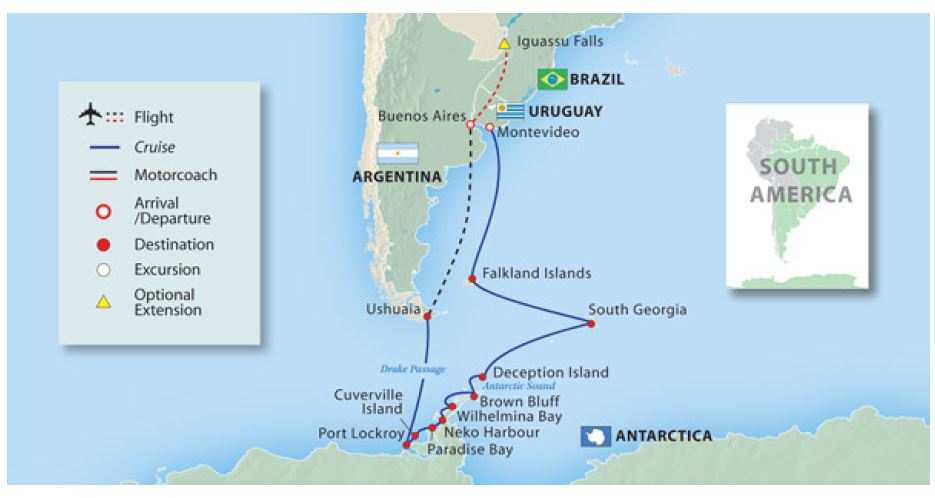
Map of my Vantage Travel / Hurtigruten Antarctica Cruise Tour (with common Antarctic Peninsula landing sites)
Let me give you some real-world examples from my trip. The evening before each shore landing, we would have a briefing by the expedition team leader. Lina would share “Plan A” for the next day’s landings (usually two). The next morning, the ship would arrive at our first landing site and drop anchor.
- Credit: Esther Kokmeijer© / Expedition team heading ashore by zodiac / (right) Team setting up landing site at Almirante Brown
- Credit: Esther Kokmeijer©
If seas permitted, the expedition team would go ashore by zodiac to set up the landing site and make sure conditions were safe for passengers to come ashore. Luckily, we were always able to do so. However, later in the trip (in the Falkland Islands), we had a couple times where the landings were almost cancelled because of high winds and rough seas.
In addition, our final Antarctica landing at Deception Island (officially in the South Shetland Islands) almost didn’t happen. We arrived to strong winds and high seas which made sailing through the narrow opening into Deception’s volcanic caldera treacherous. We were disappointed when the captain announced the landing was being cancelled. However, just 20 minutes later, the winds calmed enough for us to make a safe entry and enjoy time ashore.
- The narrow entry into Deception Island’s caldera
- Fur seal amidst Deception’s desolate landscape
On Antarctica Day #1, we experienced the situation of “Plan A” morphing into “Plan B,” which our expedition team said was common. They reassured us that in Antarctica, Plan B’s & C’s (visiting different landing sites) were always good options too. On this day, we had a successful morning landing.
The afternoon plan was to sail south through the popular and scenic Lemaire Channel enroute to a landing at Petermann Island. As we got closer, our captain spoke to the captain of a French ship who was already at Lemaire and shared there was ice blocking part of the channel. So, we promptly shifted to “Plan B” and headed north to Damoy Point for a late afternoon landing (which was still interesting).
- Damoy Point landing site – (top photos) Penguin colony / (bottom photos) Damoy Hut, a restored British refuge hut
Thus, when traveling in Antarctica, it pays to be flexible and go with an open mind and trust that the ship’s captain and expedition team leaders are working hard to create the best experience for everyone, while always ensuring the utmost safety. Yes, you & I won’t get to see everything on the long list of cool Antarctica sites, but we will see a lot – and it’s all great!
Quark Expeditions, another good polar cruise operator, states: “There are no guarantees that we can achieve everything we set out to accomplish. A measure of flexibility is something all of us must bring to a voyage.” Yes, flexibility is a critical skill for success in the Polar Game!
#6 – The Cute Penguins Will Steal Your Heart – I Just Couldn’t Get Enough
Antarctica is teeming with fascinating wildlife – including many different types of penguins, seals, seabirds and whales. As you might imagine, penguins are the #1 crowd favorite of most southern polar visitors. Certainly, I fell in love with the penguins from the “first hello!”
We saw penguins on all of our Antarctic shore landings – always the ever-so-entertaining Gentoo penguins. In fact, the main attraction at three of our five landings was visiting gentoo penguin colonies – at Neko Harbor, Cuverville Island and Damoy Point.
- Gentoo penguin waddling his or her way over the rocky beach / to right is a penguin finishing the molt
These cute gentoos, with characteristic bright orange beaks and white patches around the eyes, stand a little over 2 feet tall. Their breeding season is December – March so most of the chicks had already hatched by our late Feb. visit. That was great because we saw lots of good-sized, puffy youngsters in the process of molting off their thick juvenile down and gaining the first adult (swim-ready) feathers.
- (left) Fluffy gentoo penguin chick / (right) Penguin mom or dad sitting on the nest with two babies.
I never tired of watching the adorable way the gentoo penguins would waddle around the colony (or into the water), frequently flapping their wings. It was great fun observing parents feeding their ravenous adolescent chicks – who would continue to chase their mother (or father – shared parenting in the penguin world!), squawking for yet more food. (see video below)
We were told to maintain a 5-meter (15 foot) distance from the penguins. However, if penguins approached us, that was okay. In reality, we were often much closer to these delightful creatures because they were always in motion. Plus, they have no fear of humans (since we’re not predators!) Once a sweet young penguin (the most curious age) came over and started pecking at my pants, then my sleeve after I knelt down. Very cool! (photo below)
- Credit: Esther Kokmeijer© (above) Curious chick checking out the pants of this strange creature – a human / (left) A sweet young penguin with his head briefly resting on my arm as he checked out my sleeve. Photo taken by David Lampert / click to enlarge photos
The most common types of penguins seen on the Antarctic Peninsula are the gentoos and the chinstraps. We didn’t see any chinstrap penguins, which may have been due in part to visiting later in the season when some of the penguins have already headed out to sea to feed. The tall, stately King Penguins are primarily seen on South Georgia Island – and we saw many tens of thousands when we were there! (a future story!)
I also want to mention the magnificent Emperor Penguins because they are often the penguins we think of when picturing Antarctica. They are the world’s largest penguin (Kings are #2). Plus, you may have seen the excellent 2005 documentary about the Emperors – “The March of the Penguins” narrated by Morgan Freeman. The Emperor Penguin’s breeding colonies are primarily in East Antarctica, so they are rarely seen in the Peninsula region.
#7 – Shipboard Life on A Polar Expedition Vessel is Really Fun – Plus You’ll Learn A lot!
The title pretty much sums it up. I enjoyed all 18 days aboard our wonderful 230-passenger polar expedition ship, the MS Fram (part of the Norwegian Hurtigruten line). Our expedition cruise was longer than a typical “classic” Antarctica cruise because we also visited South Georgia Island & the Falkland Islands – giving us a total of 11 sea days!
- Credit: Esther Kokmeijer© / Our great expedition team
- Credit: Esther Kokmeijer©
Time on the cruise passes really fast – I was certainly never bored! As you would expect, the days with shore landings (we had 8 days in total) were particularly busy. However, even the more leisurely “days at sea” offered plenty of activities including thrice-daily dining room “visits” to fill our bellies with delicious food.
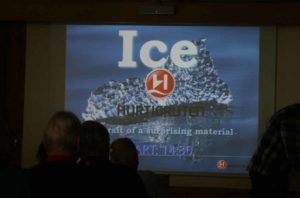
I was pleased (and honestly a bit surprised!) that every one of these talks was very interesting & well-presented (including with PowerPoint slides and photos). Who knew birds could be so interesting? (Psst – don’t tell my bird-watching nephew!) It was like being back in school, but this time I wanted to be there – and there were no tests! I learned a lot, which greatly enhanced the Antarctic experience.
- Credit: Esther Kokmeijer© / Talk on seabird’s wing spans
- Credit: Esther Kokmeijer© / Crew show performance
In addition, there were tours of the ship’s bridge and a fun talent show by the crew (music & dance) one night – complete with five men in women’s wigs and tutus! The rest of our free time would be spent in the lounge areas reading, reviewing photos, catching up on journal entries, and talking with fellow passengers from all over the world – who were a very well-traveled bunch!
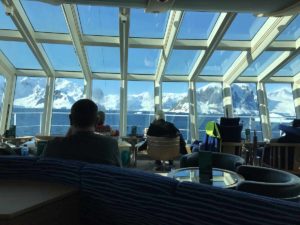
Happily, on an Antarctic expedition cruise, Nature is the star attraction! And learning about and experiencing Antarctica’s natural beauty and amazing wildlife up close is the main entertainment. To that end, the Fram’s officers, expedition team, and crew worked really hard to make our cruise the totally unforgettable experience that it was.
#8 – Expedition Ships Offer Optional Activities – Kayaking or Camping Anyone?
As if going to Antarctica isn’t adventurous enough, most expedition cruises offer passengers “adventure options” to add even more zing to the trip. These unique Antarctic experiences – usually for an extra fee – commonly include kayaking, overnight camping, and a polar plunge (described below). It’s a chance to get your polar crazy on and earn some real bragging rights!
Sea Kayaking: What a thrill to kayak in clear Antarctic waters, seeing beautiful scenery, majestic icebergs and wildlife up close. When I learned the Fram offered this option, I just knew I had to do it – and I did! I even have a certificate to prove I am now a “polar paddler!” The cost was 995 NOK (Norwegian Krone), around $116 USD.
- Credit: Judith Jacobsen
Our group of 13 kayakers, led by two kayak guides (expedition team members), explored the gorgeous Paradise Bay for 1 ½ hours in our 2-person kayaks. We wore dry suits and life preservers “just in case” we ended up in the freezing waters. We didn’t! As you might imagine, kayaking only happens when weather conditions are calm. You can read more about my kayaking adventure in my post: Antarctica Highlights/Trip Summary.
Camping: Okay, this one is even wilder – camping overnight in two-person polar tents on the snow in Antarctica! Partly because of the steep cost (around $410), I remained on the ship snuggled in my warm bed. However, quite a few passengers jumped at the chance for an “Antarctic sleepover” under the stars.
On the designated evening (after an early dinner), the campers & guides headed to shore by zodiac with their tents, sleeping bags (heavy duty, I hear!) and mattress pads. Each camper also carried a headlamp, a bottle of water and one granola bar. To avoid damaging Antarctica’s pristine environment, no other food was allowed nor could campers brush their teeth. However, guides compassionately set up a toilet (which I’m sure was packed out) behind a snow barrier near the campsite.
- Credit: Hurtigruten
- Credit: Hurtigruten
Campers had a couple hours to enjoy the quiet & solitude before crawling into their sleeping bags. Early the next morning, they returned victorious to the ship to enjoy breakfast and a real bathroom. Later, after hearing how much the campers really enjoyed this truly unique experience, I kinda wished I had done it. Hmm… maybe next time?
Polar Plunge: The Antarctica polar plunge is perhaps the craziest one of all. However, it is almost a rite of passage for many expedition ships’ passengers. Adventurous Polar Plungers jump into icy waters (temps around 0°C/32°F) in just swim suits for a “quick dip!”….Very quick!
The water entry is made either from the ship (such as the zodiac landing bay) or from a beach during a shore landing. In either case, expedition team members are standing close by to supervise the action and hand out towels afterwards. Shivering plungers quickly head for a hot shower, the sauna or jacuzzi to warm up and celebrate their accomplishment!
- Credit: ThePlanetD / Quark Expeditions
- Credit: Esther Kokmeijer© / Deception Island beach with fur seals
Our ship’s Polar Plunge was scheduled to take place when we visited Deception Island. I confess the thought of jumping into frigid waters (with outside temps also in the low 30s) did not tempt me! However, for my much gamer shipmates, the event was unfortunately cancelled because too many fur seals (who can be aggressive) were on the beach that day (photo above).
To give you a sense of this fun polar insanity, here are good posts by two other travel writers & bloggers with entertaining Polar Plunge stories: Deb & Dave of ThePlanetD (photo is Deb jumping from the ship) and Craig Platt (from Deception Island beach).
#9 – The Ship-Issued Muck Boots & Parka Worked Great!
Yes, I admit it. I developed a love affair with my Muck boots – a polar foot fetish if you will! In fact, good waterproof boots are a crucial item of expedition clothing. Like many to most polar expedition ships, the Fram provided us passengers with a free loaner pair of Muck boots for the shore landings.
These tall waterproof boots protect you when arriving ashore by zodiac for the “wet landings.” You also need them during shore exploration, whether walking through snow, ice or mud – and all the stinky penguin guano (aka poop!) in the penguin colonies. Returning to the ship, the boots are easily cleaned before exiting from the zodiac tender pit.
Muck boots are a nice new option to the traditional “rubber” boot. They have neoprene uppers and a neoprene/ polyurethane foot, making them quite comfortable for walking. And they were well-insulated so I only needed to wear a light pair of wool socks and sock liners. My feet never got cold and the boots always fit great. Did I mention that I loved these Muck boots?!
In addition, the Fram issued each of us an attractive, high quality Hurtigruten windproof & waterproof parka to wear as our outer layer. Unlike the boots, we could take these parkas home after the trip – a nice polar memento! Many other expedition cruises do likewise. When you’re packing for Antarctica, it’s great to know the proper boots and parkas are already taken care of. Thanks Fram for making the parka in blue – one of “my colors!”
#10 – I Can’t Believe It: I Want to Go Back to Antarctica for More!
Signing up for Antarctica, I truly believed that this “trip of a lifetime” would be my “one and only” visit to the White Continent. That was a key reason this 18-day expedition to the Antarctic Peninsula, South Georgia & the Falkland Islands had such appeal. If I was traveling there just once, I wanted to see it all!
That is certainly what my rational, practical mind was thinking before my departure. After all, traveling to Antarctica is a long, expensive trip and there’s a lot more of the world I want to see! And then I personally experienced Antarctica – its majestic beauty and fascinating wildlife …and I fell in love!
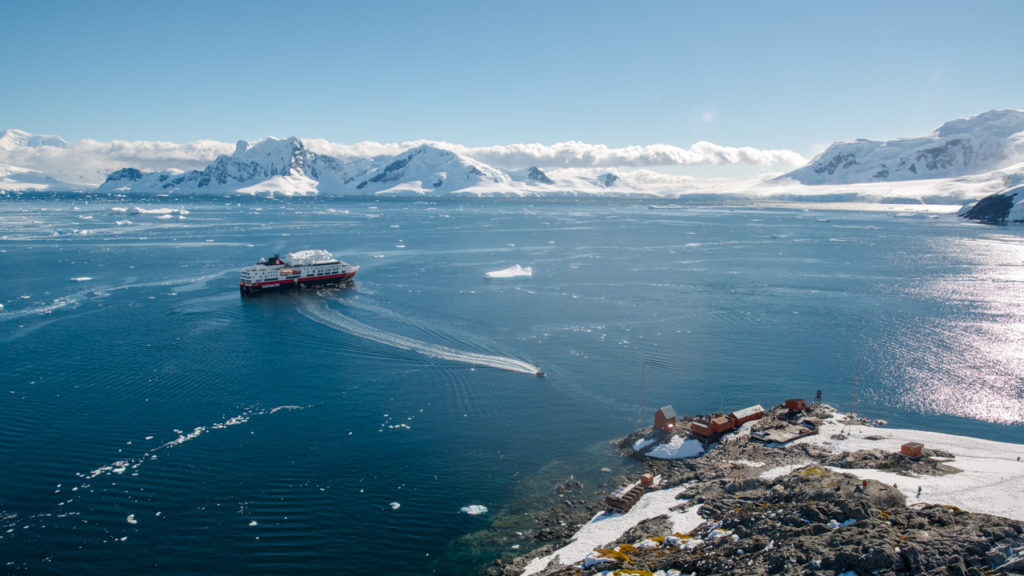
Credit: Esther Kokmeijer© / MS Fram anchored in Paradise Bay with a zodiac heading for a landing at Almirante Brown research station ( foreground) / (below) Friends Dave & Nadia standing in deep snow at the Brown base.
Antarctica was so much more than I had expected! The three days (with 5 shore landings) spent in the Antarctic Peninsula only whetted my appetite and left me wanting more. I began to understand why Antarctica has long captivated polar explorers and travelers alike.
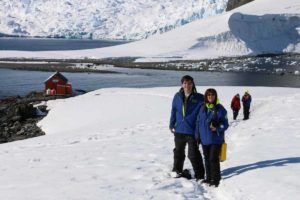
So, yes, I am adding Antarctica back onto my Travel Dream List for round #2. I don’t know yet just when or how I can make it happen, but my dream is to spend another 5-6 days in the Antarctic Peninsula. There are many more cool places & landing sites to visit and lots more adorable penguins to hang out with!
ANTARCTICA TRAVEL WARNING: Be Careful or You Too May Get Bitten by the Polar Bug!
Summary of 10 Things That Surprised Me About Traveling to Antarctica – And I Bet They Might You Too!
- Most Travelers Visit “Just” the Antarctica Peninsula – And For Good Reason
- The Absolute Beauty & Grandeur of Antarctica Blew Me Away
- It Wasn’t Nearly As Cold As I Thought – Anyone Can Do This If I Can
- Only Smaller Expedition Ships Can Make Shore Landings in Antarctica
- A Ship’s Itinerary is at the Mercy of Antarctica’s Unpredictable Weather / About Plan A
- The Cute Penguins Will Steal Your Heart – I Just Couldn’t Get Enough
- Shipboard Life on an Expedition Vessel is Fun & You’ll Learn A lot
- Antarctica Ships Offer Unusual Activities – Kayaking or Camping Anyone?
- The Ship-Issued Muck Boots & Parka Worked Great
- I Can’t Believe I’m Saying This – I Want to Go Back to Antarctica for More
Check Out My Other Antarctica Blog Posts to Learn More:
- Amazing Antarctica: How To Choose the Perfect Expedition Cruise
- Falling In Love With Antarctica – Highlights of My Recent Polar Expedition
COMMENTS: Have you visited Antarctica? If not, is a polar trip on your Travel List? Which of these ” 10 Surprises” surprised you the most?

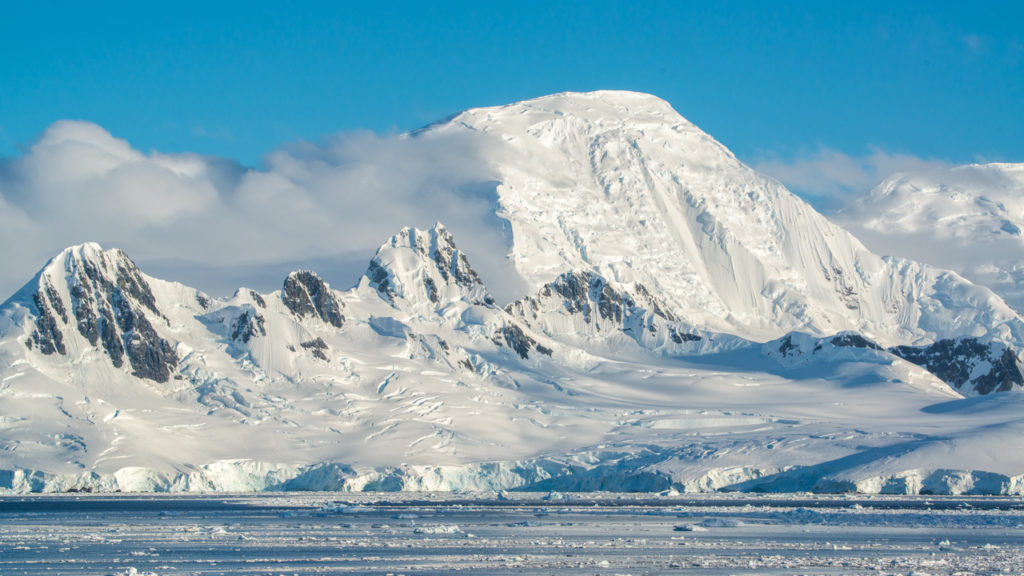

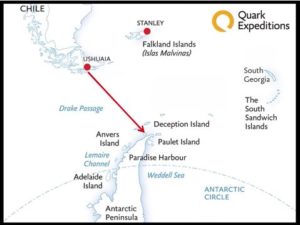
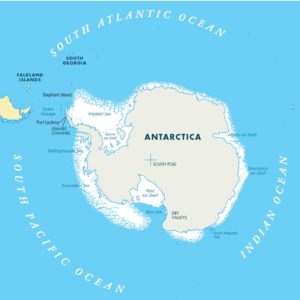
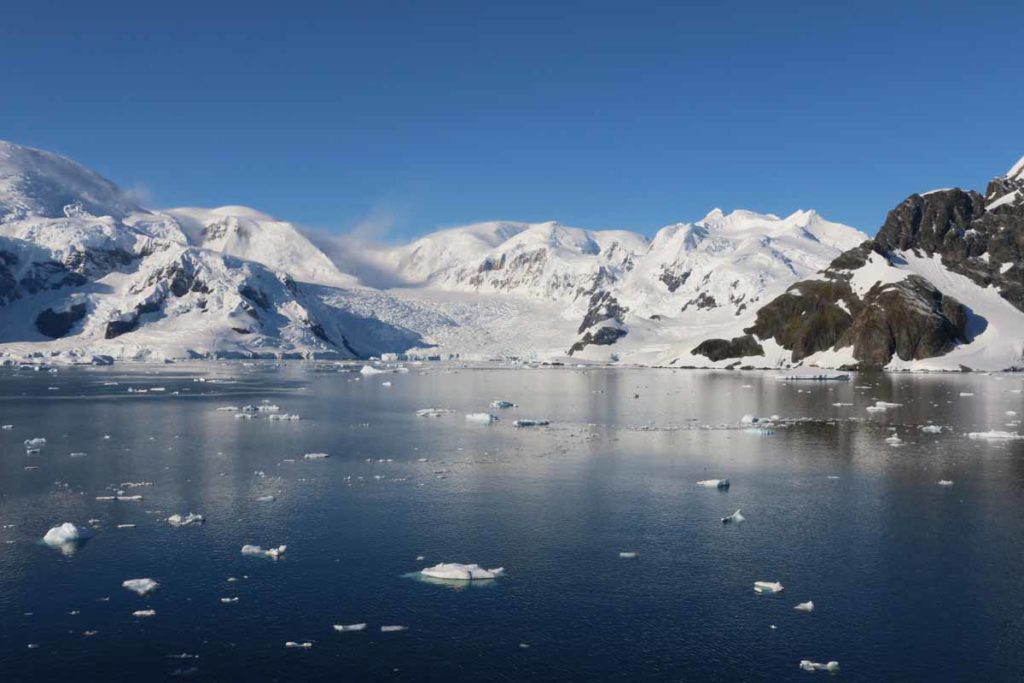
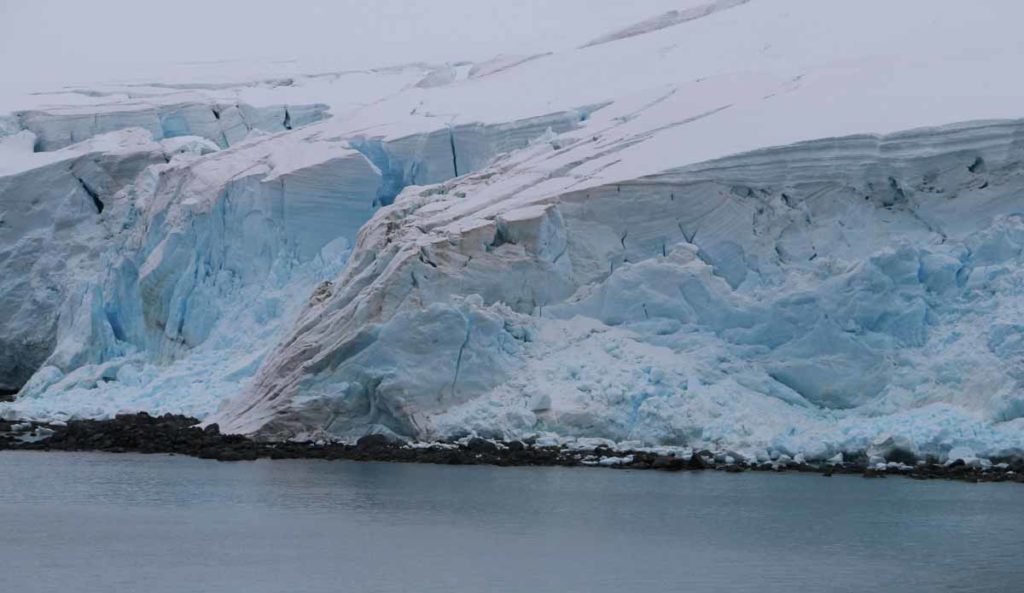
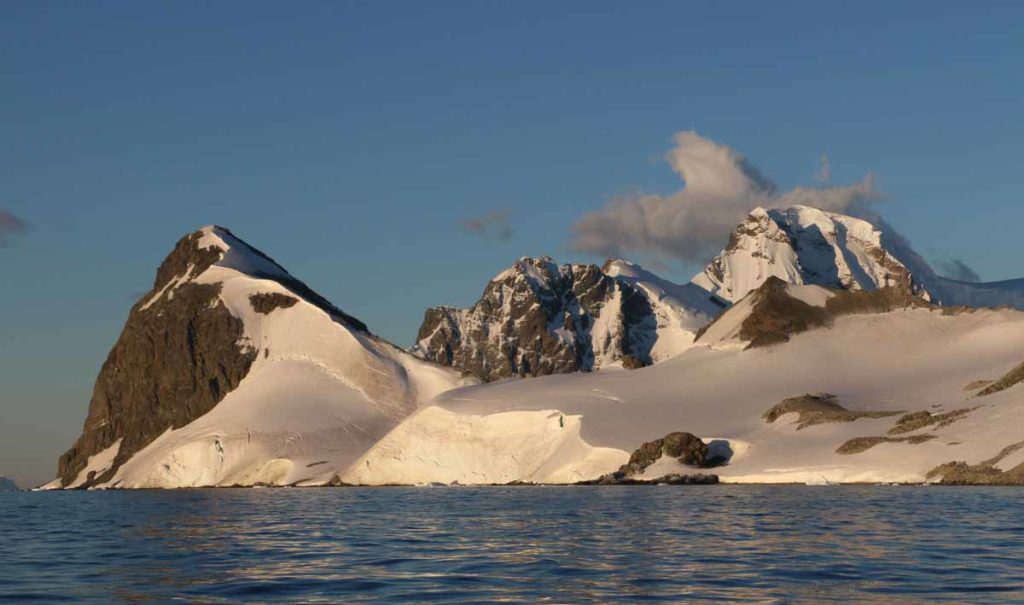
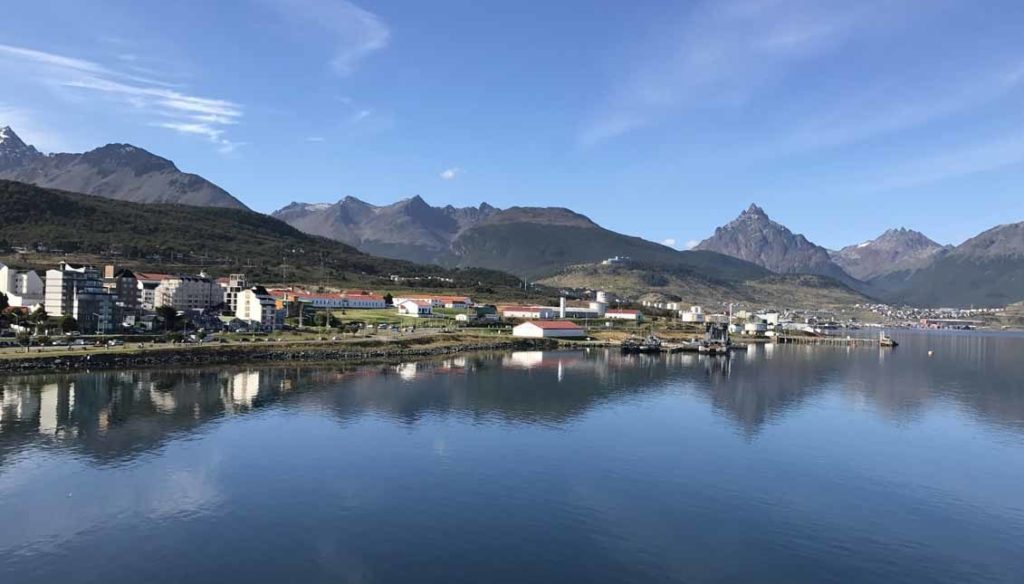
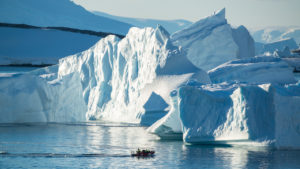
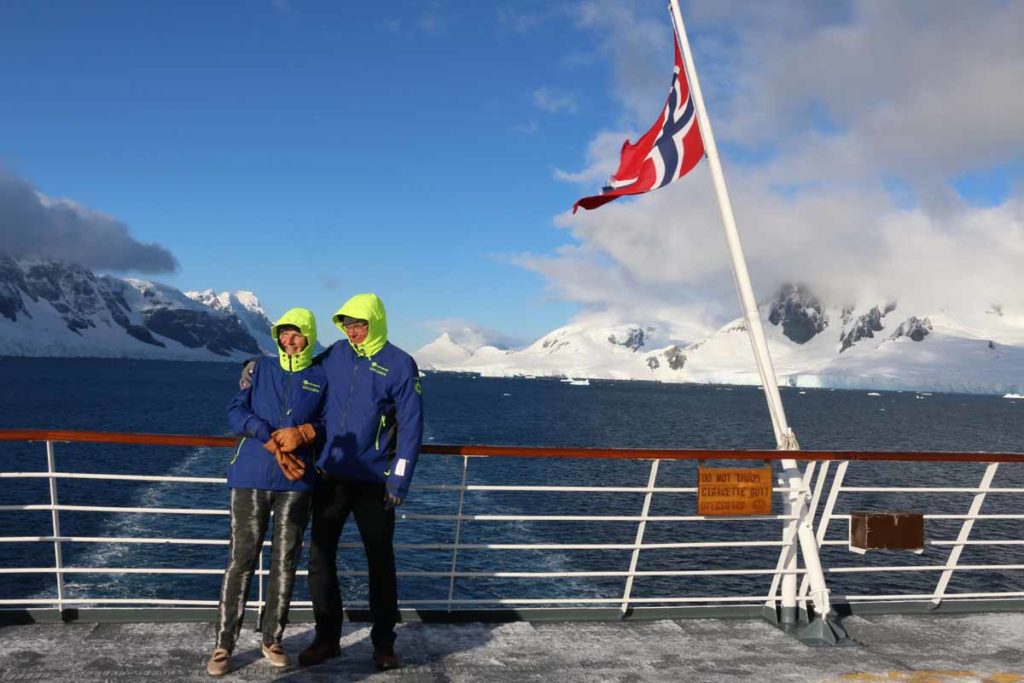
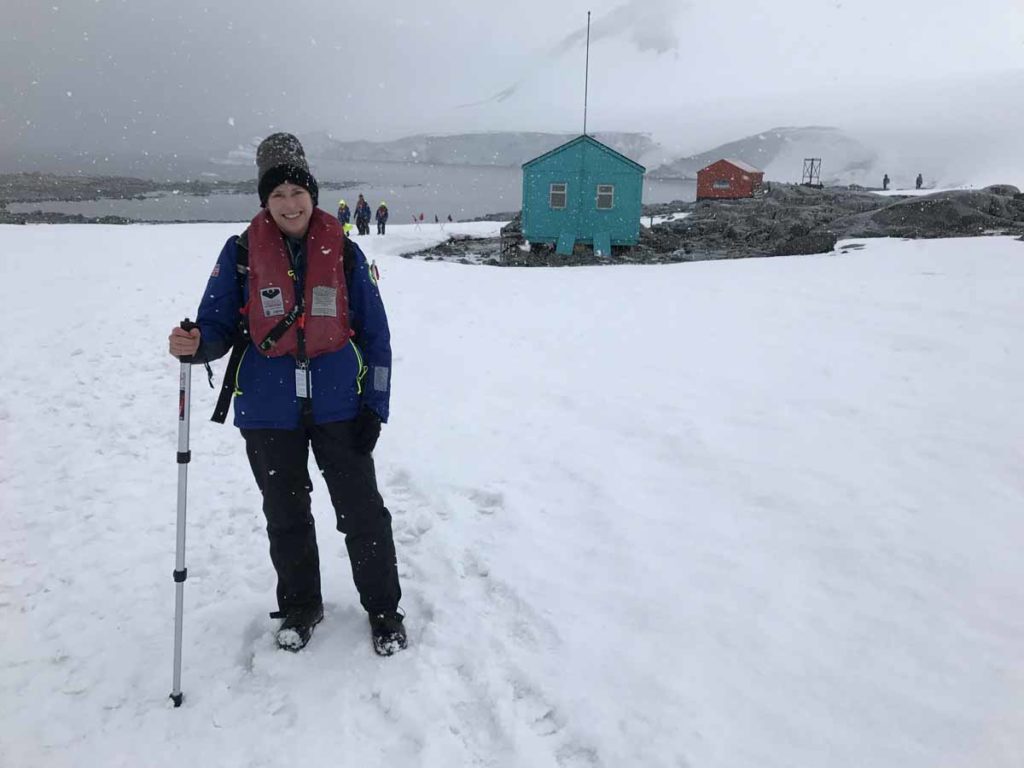

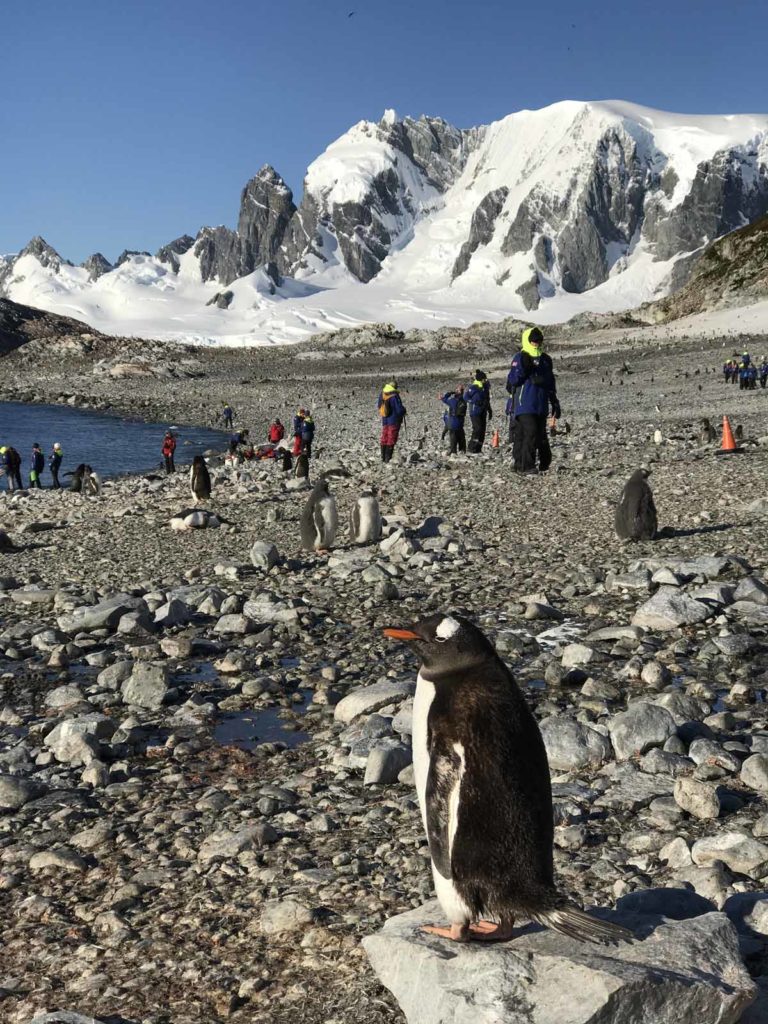
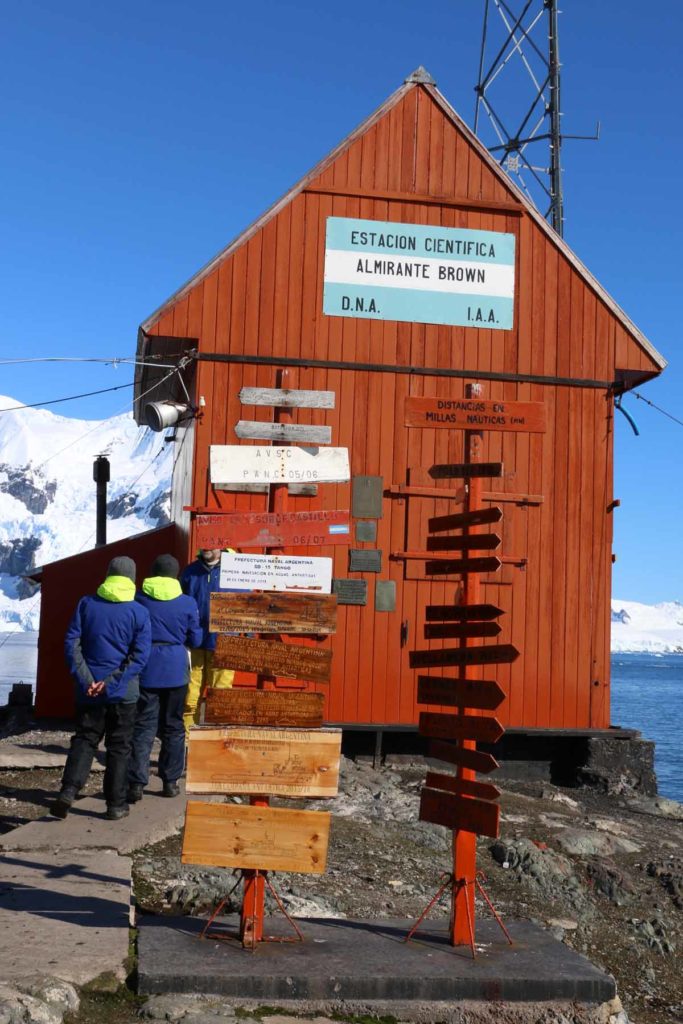
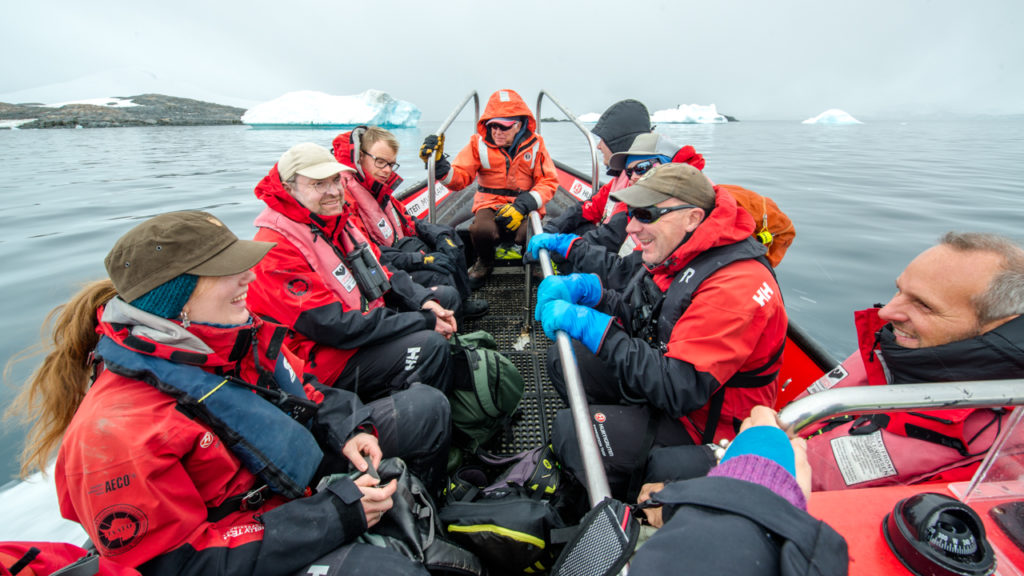
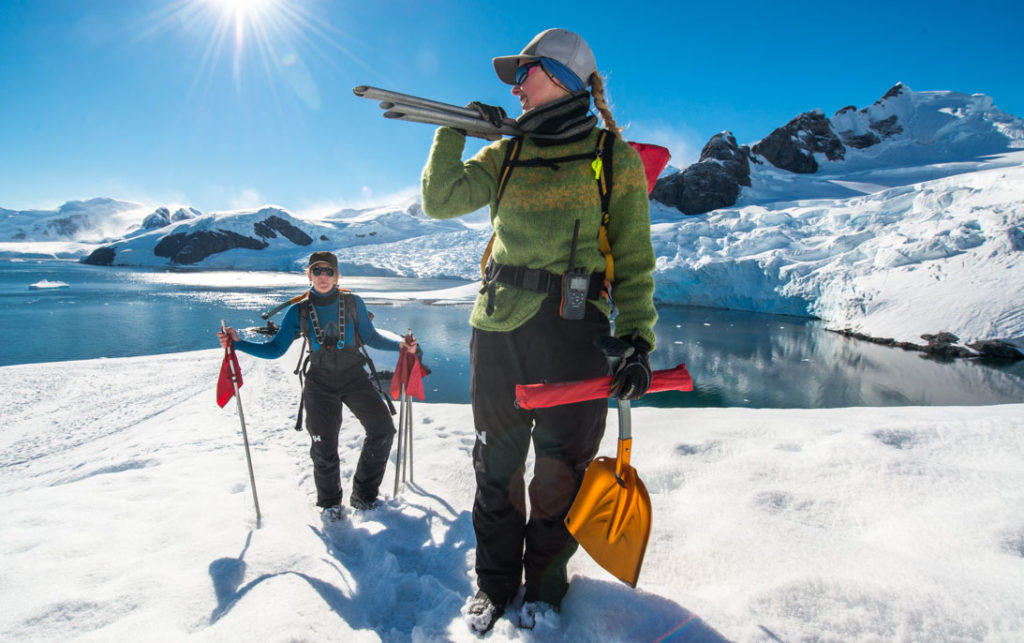
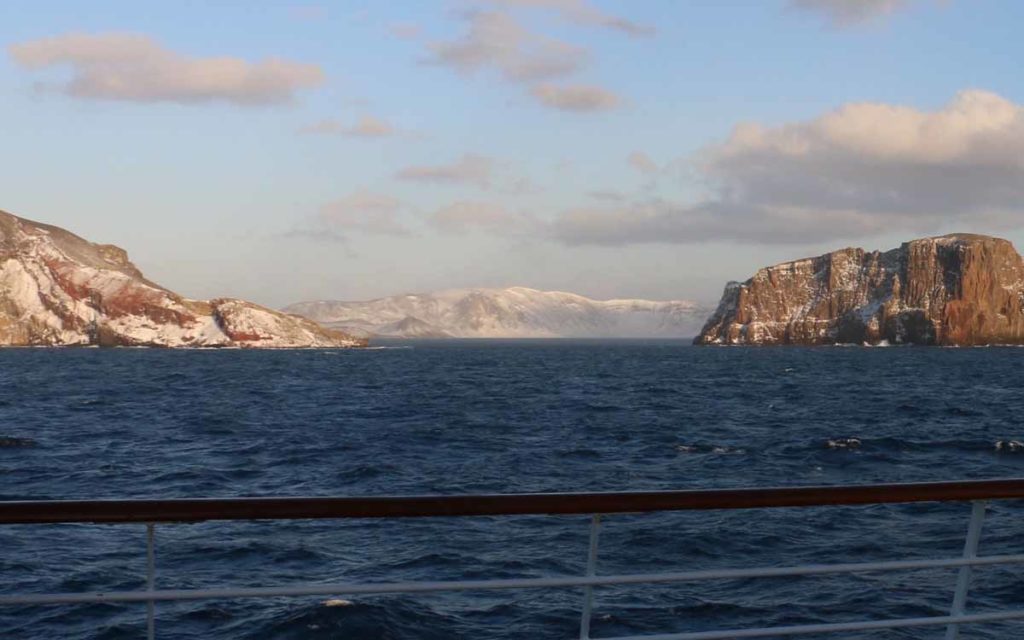
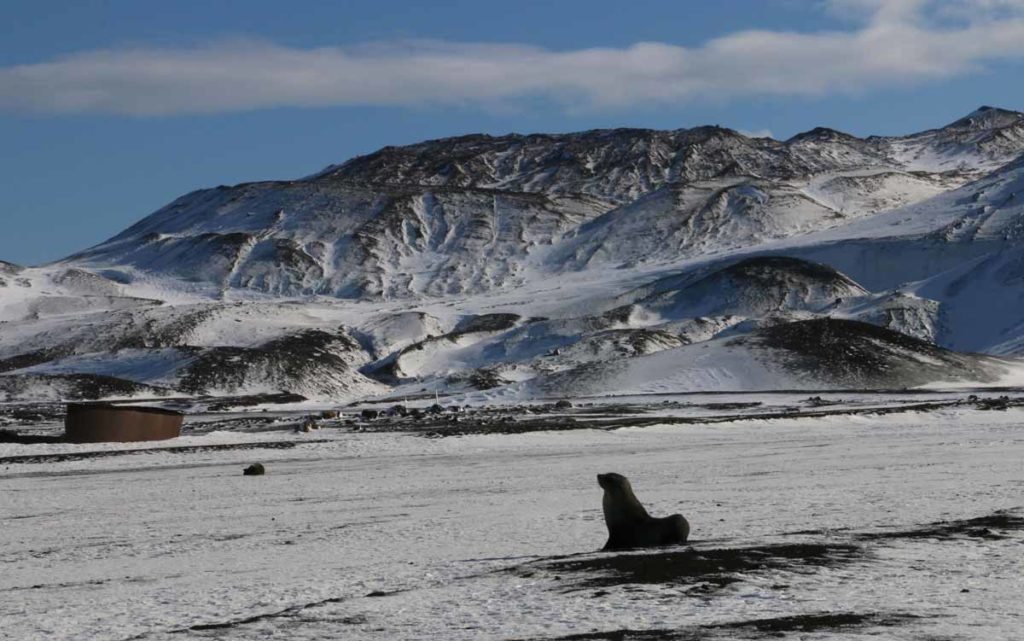
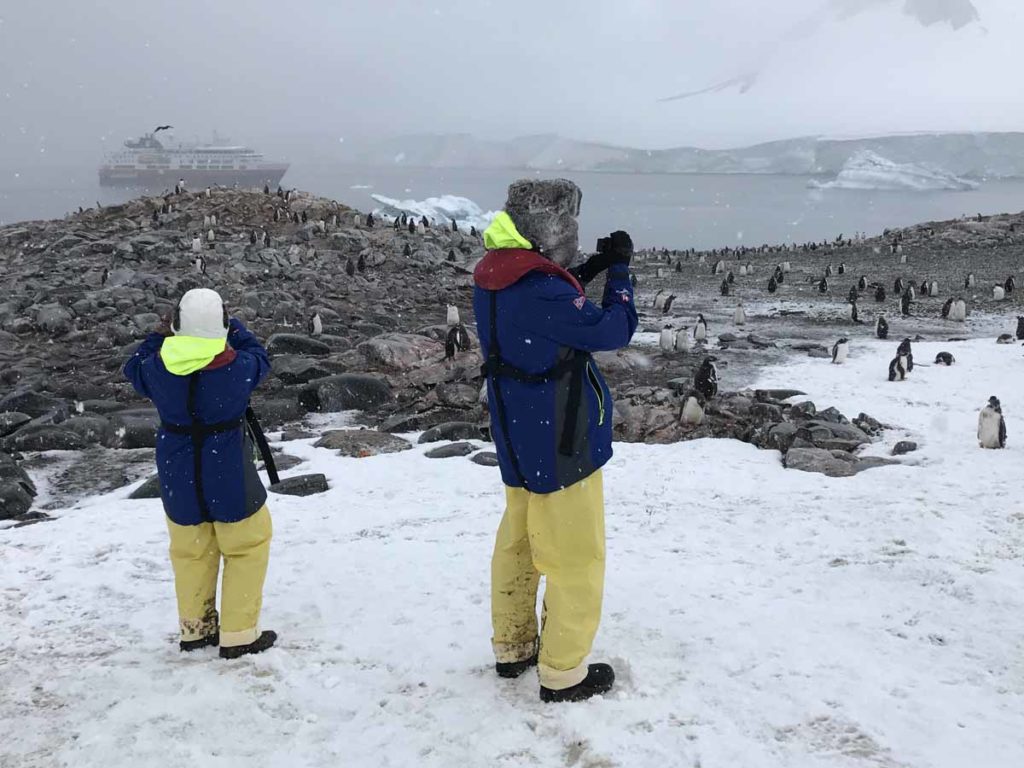
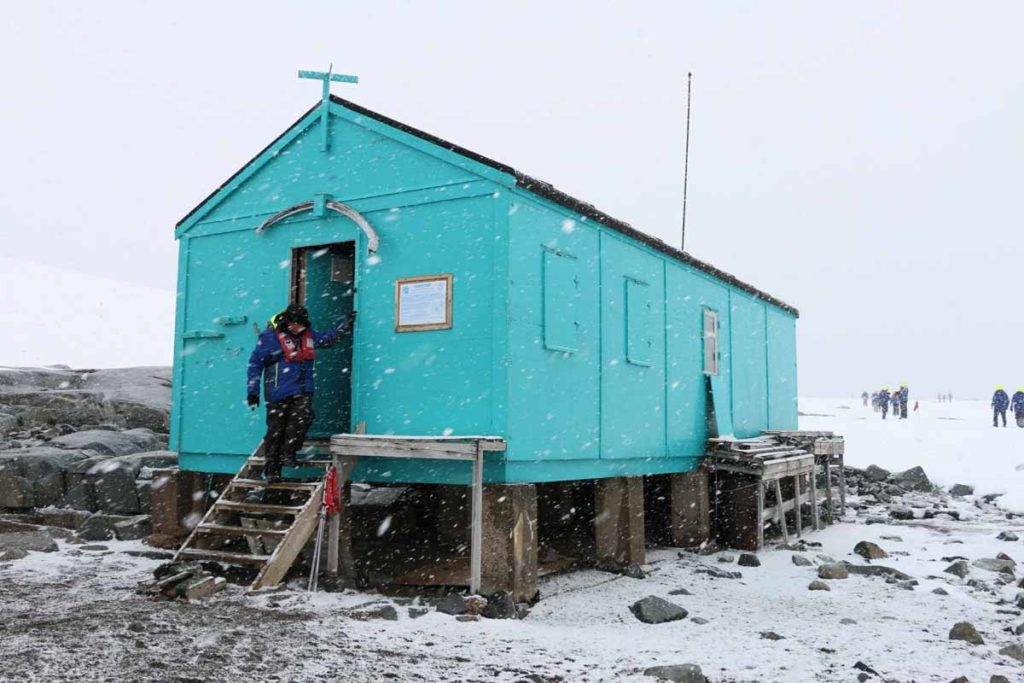
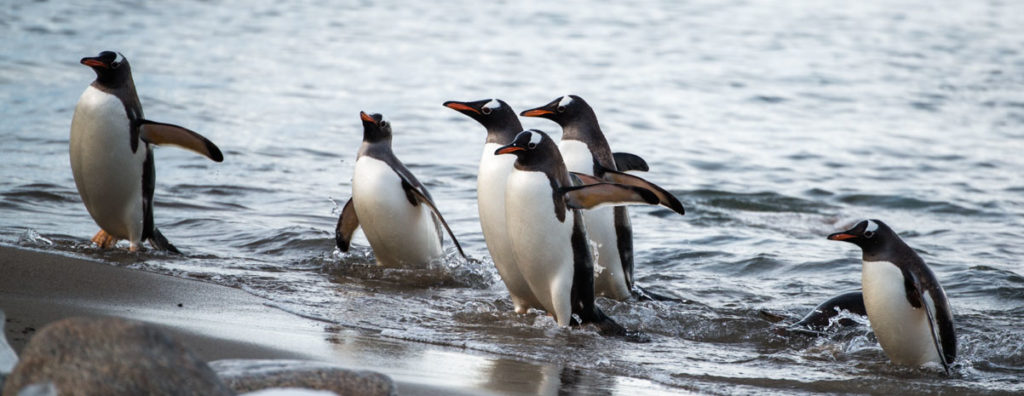
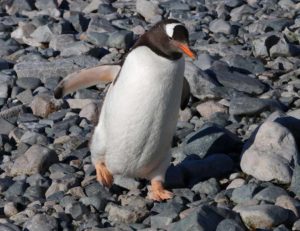
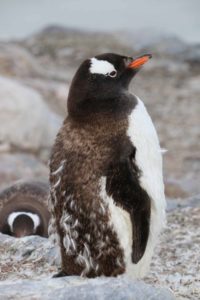
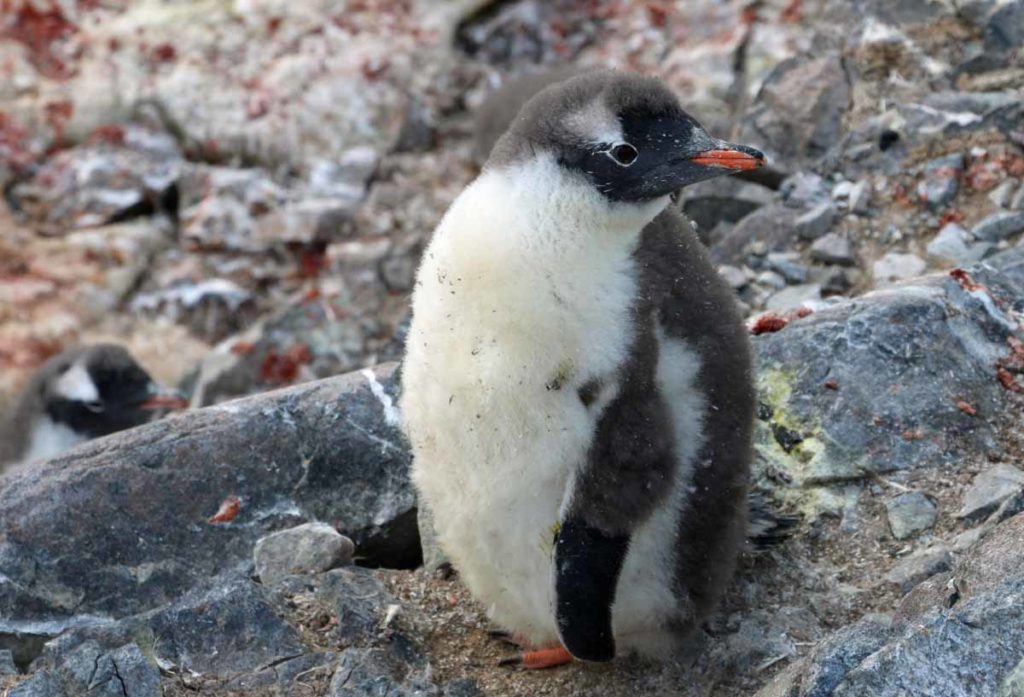
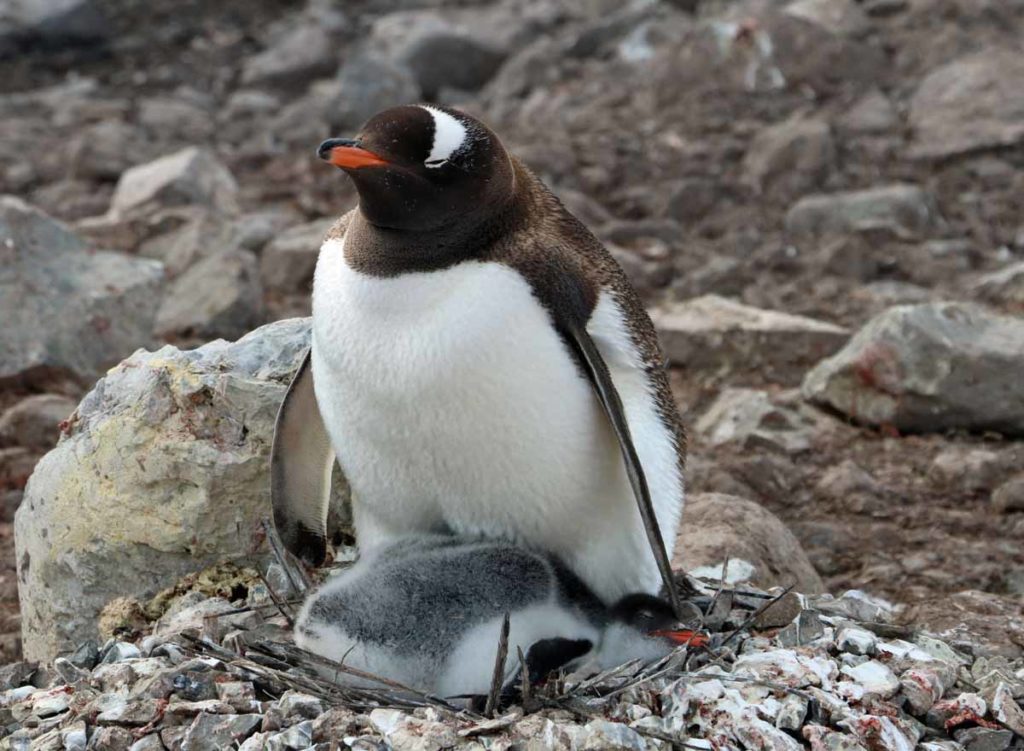
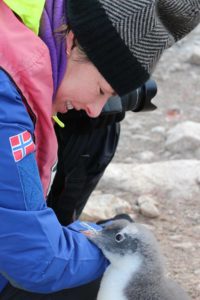
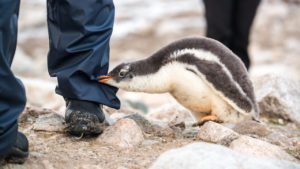
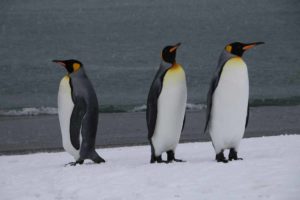
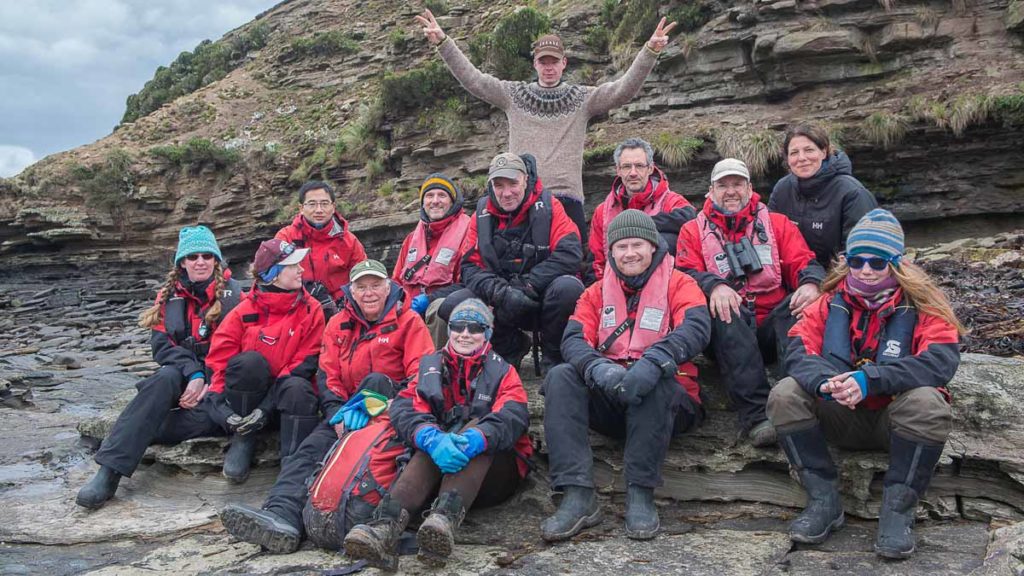
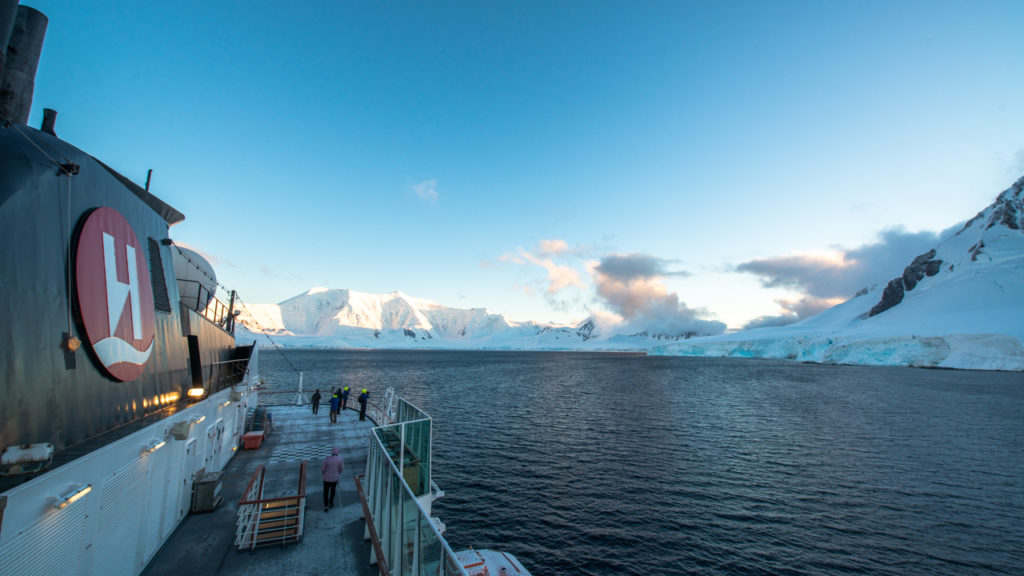

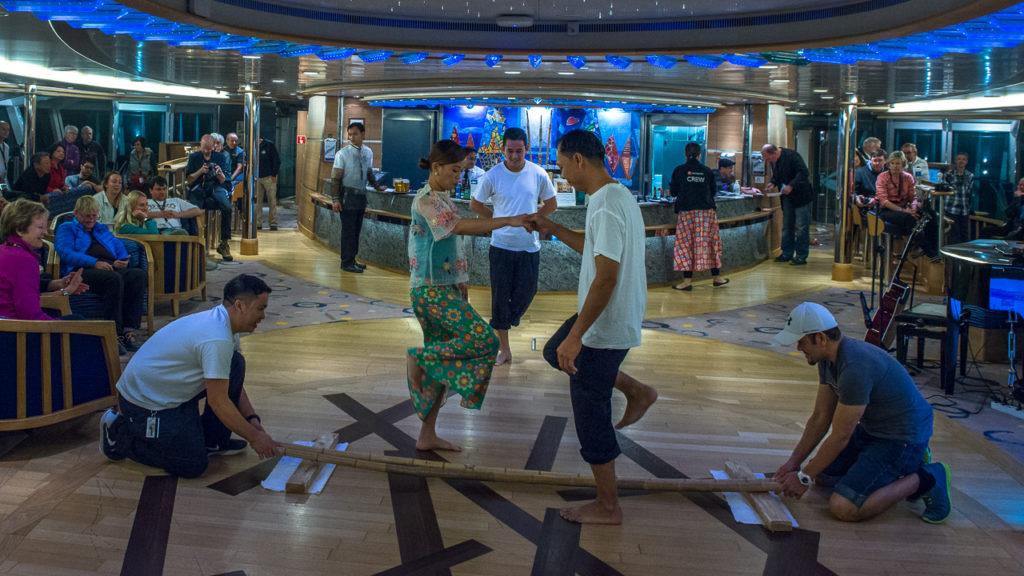
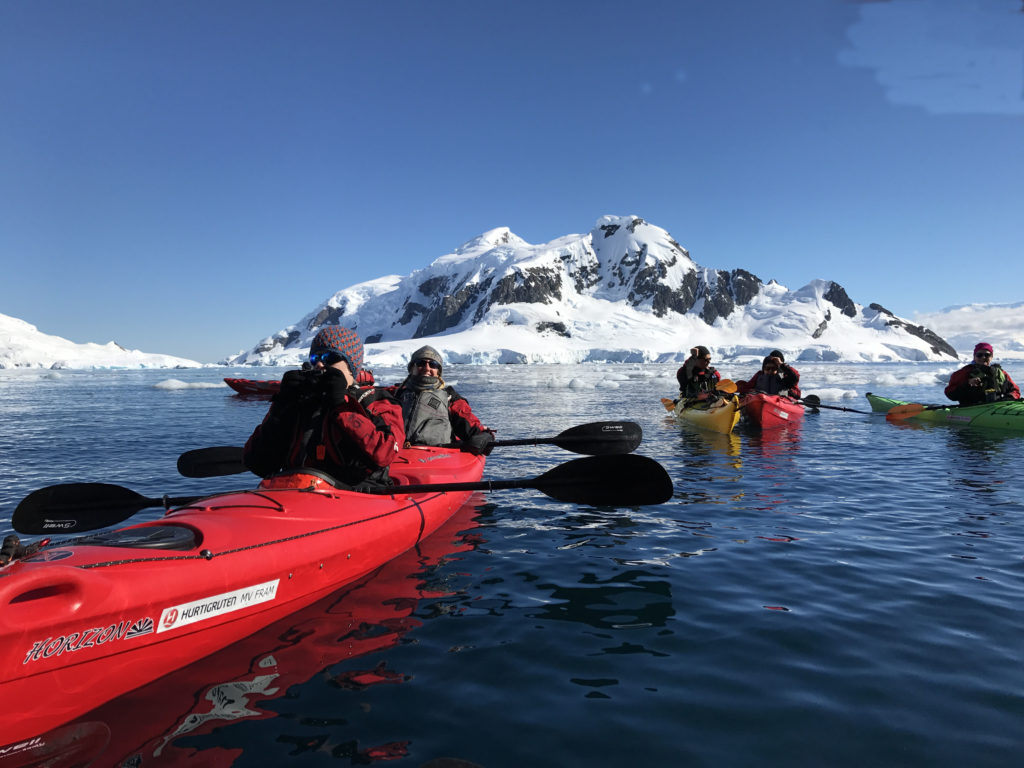
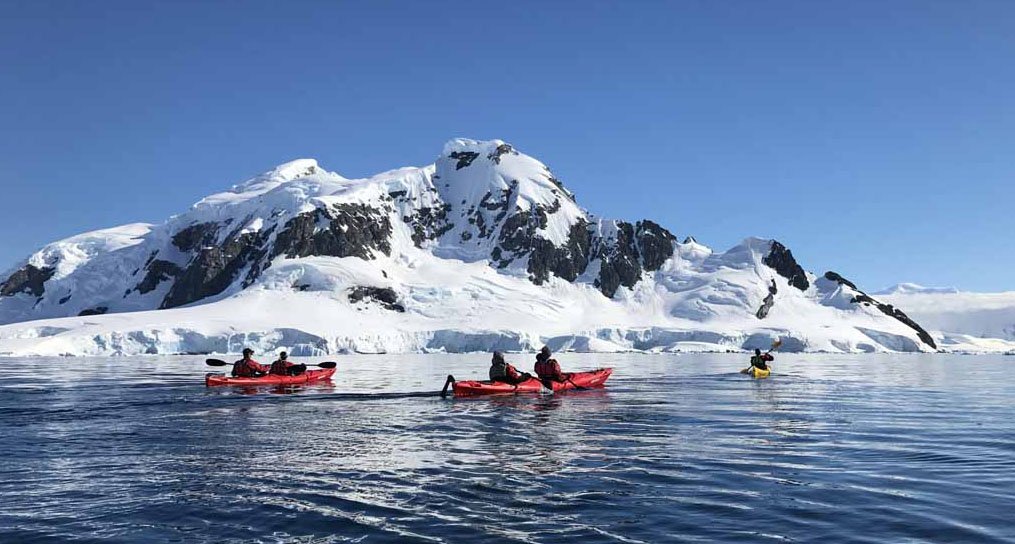
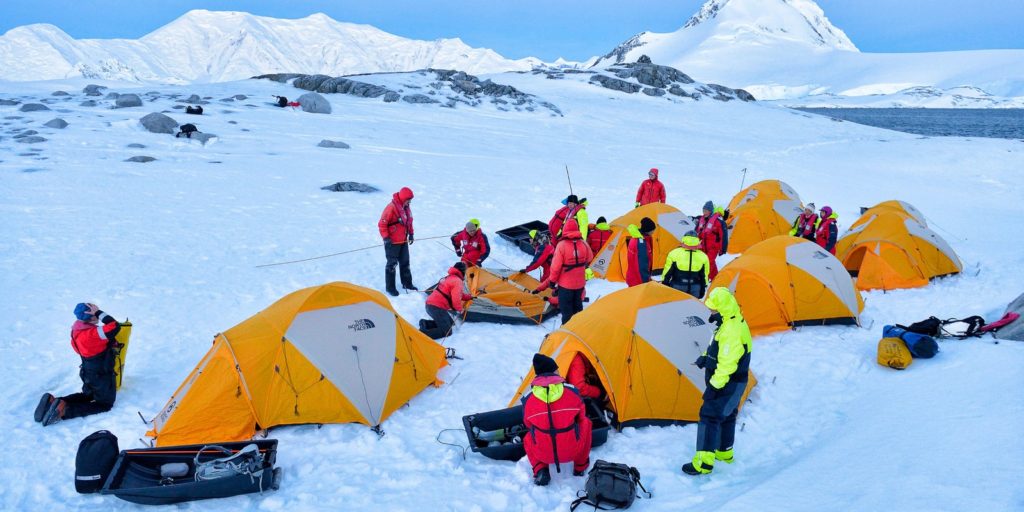
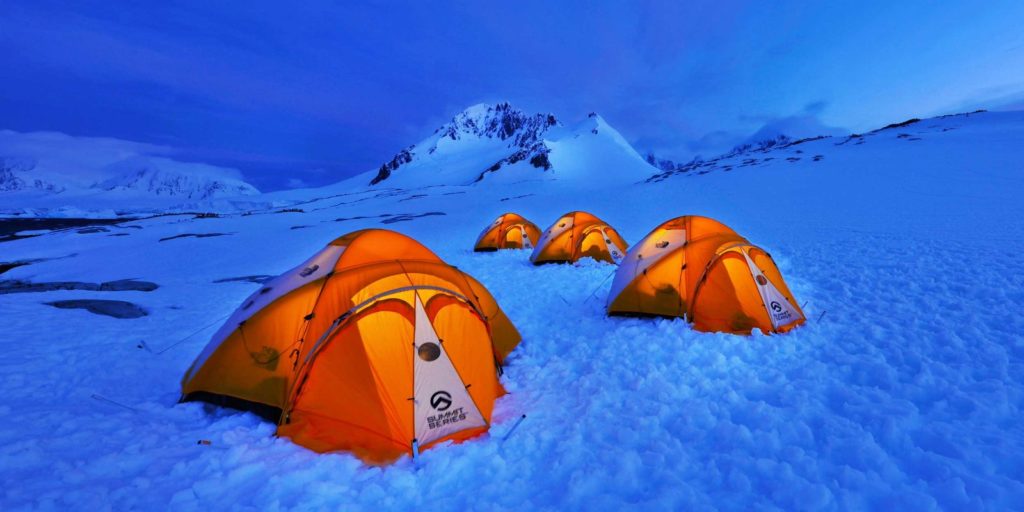
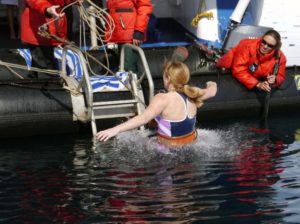
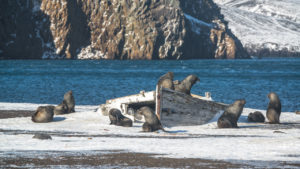
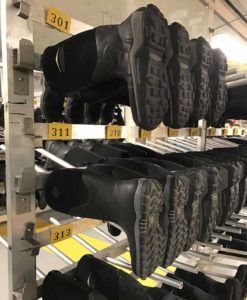
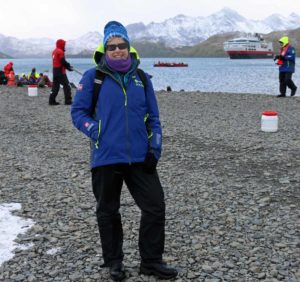

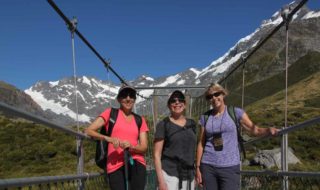
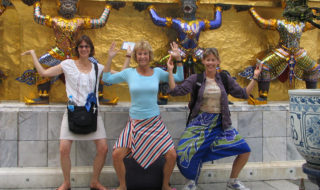
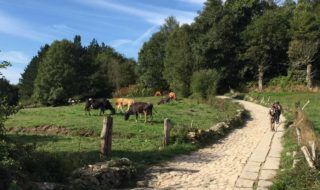
I, too, was surprised that is wasn’t as cold as expected on most days. Granted, we did wander around on some of the landings in a snowstorm (South Georgia), but most of the landings were gloriously sunny and warm. On one Antarctica landing I remember being too warm in my Hurtigruten-issued jacket.
Your list of surprises is right on target. To add to it, I’d say that I was also surprised at how blue and big the icebergs were. I was also surprised at the grandeur of the King penguin colony at St. Andrews Bay in South Georgia. There’s no way to describing seeing nearly half a million penguins in one place.
Thanks for the great post!
Thank you, Marnie and you’re welcome. Really good to get your feedback & perspective from a fellow Antarctica traveler. Great additions!
I learned so much about Antarctica from this article. It is well thought out and well written, and easy to follow. There is a lot of good information that summarizes what there is to like about Antarctica. This is particularly helpful for people like me who know nothing about Antarctica. Am passing this along to my wife – maybe one of our future trips??? Loved the pics of people camping in the snow. The pics made all the difference, and tell a 1,000 words!
Thanks so much, Mark. Really glad you enjoyed the article and found it helpful. I certainly hope you & your wife are able to visit Antarctica someday soon. Do let me know when you do!
This was a great summary of your Antarctic experience, nicely done.
As I began reading two questions came to mind: Did you cross the Antarctic Circle, and what about your foul weather gear? It appears you did pass south across the Circle but I’m not certain. And then you did describe your Muck boots and parka. So I assume you brought everything else with you. You’ll never get to use those items in SoCal so you WILL need to go back again. ;^)
Thank you Tim! No, we did not cross the Antarctic Circle. I just rechecked a more detailed Antarctic Peninsula map to make sure. From what I can tell, the majority of expedition cruises that visit the Antarctic Peninsula stay above the Circle because so many of the popular landing sites are located there. About the cold weather gear – yes, I brought everything else. Luckily, I already had almost everything I needed because of outfitting for past cold weather trips – winter Iceland to see the Northern Lights & trekking in Nepal in the Everest region. Yes, living in San Diego, those clothing items don’t get used a lot so they can last a long time – Perhaps for that return Antarctica trip someday!
I loved reading all about the adventure, and like you said, Janet, I now understand much better why people like you rave about it! Thanks for another great travel adventure.
Thank you so much, Laura for your very nice words! Glad the blog post helped articulate why Antarctica is so special – and often so different from what we might imagine until we get first person accounts!
Hi Janet,
Thank you for posting this and I also long to return. It was a fantastic and an unforgettable trip. Wish Bill could have joined us.
Thank you, Steve. Yes, I agree that our delightful BTO group had an amazing adventure to Antarctica. And we have Bill to thank for making it happen. We will be forever grateful to him for showing us some of the world’s greatest treasures.